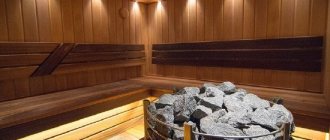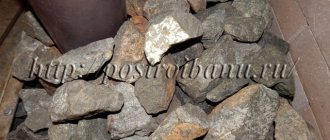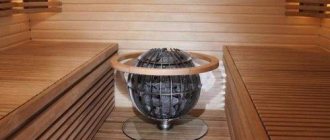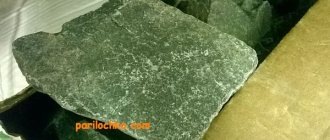The stove in the bathhouse is the most important person. The way of life in the bathhouse kingdom depends on it. And sauna stones are the heart of any stove.
And we need a healthy, strong, durable heart. Therefore, natural stones are suitable for backfilling the heater. The requirements for them are quite serious. They are required to withstand enormous temperatures and retain heat for as long as possible. Based on these requirements, the specific gravity needs to be decent. So where do we find such talent?
What is the best stone for a bath?
What stones are best to choose for a bath? This question remains open for novice bath attendants. The breed must be safe and not emit harmful fumes and have certain physical properties.
- Heat capacity. This is one of the main factors in choosing a stove stone. It should retain heat for as long as possible. The higher the indicator, the longer and more uniform the heat transfer will be.
- Heat resistance. The higher the level, the more heating and cooling cycles the bath stone will withstand without loss of properties.
- The best stone for a bath is heavy.
In addition, when choosing which stones are best for a bath, you need to pay attention to their environmental friendliness and uniformity. The rock should not contain inclusions to avoid dispersal and uneven heating. It is better to give preference to round, smooth stones, approximately the same size, without cracks or chips.
Density and heat resistance are easily checked. It is enough to heat the sample to maximum temperature and immerse it in cold water.
Collect or buy stones?
It is not necessary to buy the breed in a store. It is enough to walk along rivers or along mountain slopes, where you can collect stones for a bath. It is important that the reservoir be fresh, since the usual sea pebbles are not so durable. Natural material undergoes natural treatment for many years by natural influences, water, and sun.
Rocks that are durable and resistant to temperature changes are:
- gabbro-diabase;
- jade;
- soapstone;
- dunit;
- porphyrite
And the most beneficial for the human body, although less heat-resistant, will be:
- crimson quartzite;
- white quartz;
- basalt.
Before you decide which stones are best for a bath, you need to make a choice between a specialized store and an independent search. And if the first option is more expensive, but safer and more reliable, then the second, although free, requires time and certain knowledge. You need to understand the breed and not stumble upon a dangerous species.
Some inexperienced bathhouse attendants, unknowingly, collect along the railway tracks. And such stones can be suitable for a bathhouse, if we talk about physical properties. However, such rocks undergo chemical treatment and accumulate many harmful components. This can be harmful to your health.
Therefore, without certain knowledge and experience, it is better to give preference to specialized stores. Professionals will help you choose stones for the bath, tell you which ones are best to buy and give advice on placing them in the stove. In addition, such samples undergo special treatment against bacteria and microorganisms that can negatively affect the body.
Important Features
As mentioned above, sauna stones must be environmentally friendly, homogeneous and solid. For uniform heating, you should choose rocks of the same size. There are a number of other points that are worth paying attention to:
- absence of white spots on the surface that can be scratched with a fingernail;
- absence of small fibers (asbestos);
- purity of the material.
It doesn't matter whether the stones were collected yourself or bought in a store. Before laying them out, they must be thoroughly rinsed with water, even if they seem clean.
Which stone is better for a bath: chipped or polished? It all depends on individual preferences. The former, according to experienced bathhouse attendants, have a larger area of contact with water, which means more steam is generated. The second option takes longer to warm up, but provides better circulation of warm air in the sauna.
Types of stones for baths (video)
The best stones for a bath in terms of durability
Different breeds differ in durability. Not every stone can withstand a large number of heating and cooling cycles. Since, being in a steam room, many people prefer to pour water on the hot stones for better steam release. Such exposure may have a negative impact on them.
Which bath stones are better in terms of durability:
- nephritis (up to 10 years);
- porcelain (up to 10 years);
- cast iron (up to 6 years);
- dunit (up to 6 years).
Bath attendants' advice
Bath stoves are allowed to be filled with several varieties. Minerals with the lowest heat capacity are placed at the bottom, then with the average value, and at the top - with the highest value.
- replace the mineral filler every 3–4 years (porcelain, cast iron and stainless steel products last for decades);
- soapstone is often washed from dust, calcined and washed again with water, dried;
- When selecting mineral backfill, you need to buy/collect samples with the least porosity and high specific gravity.
It is better to buy bath filling in stores. The product is tested for safety and treated against fungi and infections. They have a large assortment of minerals of different fractions. They also sell mixes: 2–5 types of stones in one package.
Porphyrite and similar rocks crack during the first calcination, then the sound disappears. If the cracking continues, the backfill must be changed.
The best stones for saunas and Russian baths:
| Oven type | Ideally | Recommended for backfilling | Suitable for use in baths/saunas |
| Boulders in contact with fire (Kuznetsov designs or periodic action) | Jade, cast iron, chromite | Porcelain balls, quartz | Varieties of dunite, soapstone, rodingite, porphyrite |
| Open heaters (minerals are doused with water) | Rodingite, quartz, jade | Jasper, jadeite, dunites | Chromite, gabbrodolerite, porphyrite, soapstone |
| Closed heaters, open bottom stoves | Porcelain, quartzite, cast iron grades SCh20, ChH16 | Jasper, quartz, rodingite | Dunites, jadeite, porphyrite, varieties of diabase, nephrite |
| Sauna stove (minerals are in contact with air: the top is open, the stones are held in place by a mesh around the structure) | Jasper, jade | Balls made of ceramics or porcelain, quartz, jadeite | Gabbrodolerite, rodingite, quartzite, dunites, chromite |
Natural minerals that do not contain harmful impurities are suitable for a Russian bath or Finnish sauna. There are many types of backfills and a wide price range. The cheapest of all is natural river boulder or sea pebbles. They cost from 10 rubles/1 kg.
In addition, watch a video about how to assemble a sauna stove yourself:
What backfills are used in your bathhouse? Comment on the article, share your experience and interesting filling options. Send information to friends on social networks. Best wishes.
Which stones are best for a steam bath in terms of heat capacity?
Heat capacity is the most important characteristic. Before you buy, you need to figure out which stones are best for a steam bath in terms of heat capacity. After all, the rate of heating and the time of heat retention inside the rock depend on this. Homogeneous samples with high density are ideal for this property:
- nephritis;
- cast iron;
- porcelain;
- porphyrite;
- soapstone;
- dolerite;
- chromite;
- Rodingitis.
What are the best stones for the sauna stove in terms of health safety?
There are rocks that, when heated, emit fumes that are harmful to health. Therefore, it is necessary to focus on which stones cannot be used for a bath.
Radiation
The issue of radiation is relevant for those who decide to collect stones themselves. It is important to consider not only the breed itself, but also the place where it was collected. It has the property of accumulating radiation in itself. That is why it is necessary to check the background radiation of the area.
So, ordinary pebbles, which can be found near any body of water, are suitable for a bathhouse. However, it is not only dusty, but also accumulates radiation, the level of which can be several times higher than the permissible level.
When purchasing stones, you need to pay attention to the packaging. If there is an inscription: “The product has passed radiation control,” then you can safely purchase them.
Rocks have the lowest background radiation. But it is also necessary to check them with a dosimeter.
Sulfides
If, when heated, the stone emits a sharp, pungent odor, this is a sign of the presence of sulfides. On the surface they are visualized as tiny crystals. It can be cleaned.
Gabbro-diabase and porphyrite are especially susceptible to it. Therefore, they must be carefully checked before display.
Other impurities
In addition to sulfites, sauna stones may also contain other man-made impurities. One of the most common is creosote.
It is important that the rock is not collected near railway tracks or near industrial facilities. This way there will be the least chance of exposure to harmful fumes.
Dust
Stones tend to break down during use, forming dust. For this reason, they need to be sorted out and the heater cleaned of waste. But there are also those who distinguish it within the framework of a natural process. For example, soapstone. During operation, it regularly releases talc and chlorite. The smallest amount of dust is generated from soapstone.
Best stones by cost
Oddly enough, when buying stones, the principle “the cheaper, the better” applies. And the most budget-friendly is gabbro-diabase.
This breed has a high level of heat capacity and heat resistance, which is especially important for a bathhouse. It is impossible to predict the service life: it all depends on the type of heater. This rule applies to all stones, so you shouldn’t trust advertising 100%. After all, for some, ordinary river pebbles can last more than 10 years, while for others, jade only lasts for a year. Moreover, if the stone is cheap, it is easier to replace it, unlike expensive rocks.
Video on the topic
FAQ
Is it necessary to fill all the small cavities inside the Kutkin stove with small pebbles, in which there is a gap of 3 cm between the casing and the body? Or does it only need to be filled in the central part?
The gap is a structural element that ensures proper heat transfer. There is no need to fill it with small stones.
I put the purchased porphyrite in the stove, but for some reason it cracks when fired. Isn't this dangerous?
Porphyrite may crack slightly during the first or second heating - this is normal. But if the crackling sound is heard constantly, the stones should be reconsidered and, if necessary, replaced. Perhaps you received heterogeneous specimens with foreign impurities.
I installed a convection oven in the bathhouse and laid it with stone according to all the rules. But the stones do not heat well, although the temperature in the steam room is high. What's the matter?
Economical convection ovens are much more often used in saunas rather than Russian baths. They were purposefully created in order to reduce the amount of fuel and time to heat the room. That is why short heating leads to maximum heating of the room, and the stones do not have time to warm up. No matter how you arrange them, they will produce weak steam. For a Russian bath you will have to change the stove or install a steam generator.
Which bath stones are better in terms of durability?
There is an opinion that the most durable stones are those that are of deep igneous origin with a silica content (up to 50%). It will be easier to understand which stone is better for a bath, guided by the table.
So, for example, even those breeds that have the same name can have a variable composition. Therefore, it is necessary to take into account the mineral components and the maximum heating temperatures of the heater.
According to statistics and composition, the most durable are jade, ceramics and food-grade stainless steel. By combining them in the oven, you can forget about replacement for more than one year. But such a composition is very low-budget.
What you need for work
To be honest, all work with the stove is the worst! Soot, soot, ash, coals - all this is difficult to wash and does not wash well. I advise you to prepare clothes that you don’t mind throwing away later. Thick rubber gloves are best for work.
It is also necessary to have a supply of new stones for the stove to replace those that you discard during the process.
Be sure to prepare a large tank in which you will place stones.
Stiff brushes will also come in handy. Some bath attendants use a variety of chemicals to clean stones to remove carbon deposits and scale. They even use diluted citric acid.
I am against using any chemicals in the bath, so I use simple river sand to clean the stones. A stiff brush, sand, running water - that's all I use to clean stones.
Which form is better
For a stove in a steam room, it is better to choose round, flat stones. They have greater heat capacity and are more convenient to install in the heater. Considering that many minerals have a different shape, you need to select samples of more or less the same size: 5-7 cm and 8-13 cm in diameter.
It is not enough to choose the right stones. It is important to place them correctly in the sauna stove.
Before laying, you need to check them for cracks, sulfides, and dust. Then, soak in saline solution and leave for 2 hours. After that, dry it.
Installation order:
- Large stone samples.
- Average.
- Small ones.
The samples may be approximately the same diameter. But then you need to take into account that the diameter is at least 7 and no more than 15 cm in diameter.
If the heater is iron and small, then it is better to use medium-sized specimens. In electric ovens, due to the narrow spaces between the heating elements, small stones are placed.
In large wood-burning stoves, large samples are used for proper heat transfer. It is possible to use small ones if dense installation is intended. This way, water will not get on the metal elements of the stove, and the steam will not be heavy with a metallic taste.
Combining small and large rocks will increase the specific heat capacity of the heater. If medium- and fine-grained stones are used, this will ensure uniform distribution of water over them and reach the bottom layer of the masonry. So, the steam will be more stable, dry and soft. When the question arises about which stones are best for a bath, you need to rely on these nuances.
During laying it is necessary to harden the stones. To do this, you need to heat them until red and quickly pour cold water on them. After cooling, you should carefully inspect them for defects and cracks. If detected, remove the samples and replace them with new ones.
Although heat transfer and steam formation depend on correct installation, you also need to make sure you pay attention to water. It should be clean and hot. This will increase the life of the stones and provide a large amount of steam.
Laying stones in a sauna stove (video)
How to properly care for stones in a steam room
Even stones need proper care. The breed is used during sudden temperature changes, which negatively affects their integrity. When they become unusable, their characteristics also decrease: the level of heat transfer decreases to 30%.
Therefore, it is necessary to sort through the stones annually, conducting a thorough inspection for defects. If they are found, the samples must be discarded and replaced with new ones. Whole specimens must be washed to remove soot under clean running water and returned to the heater.
If you regularly use a steam room, it is recommended to completely replace the stones every 2 years. If the bathhouse is rarely used, then this is not necessary.
Arrangement
For different stones and different stoves, you can find different recommendations for laying stones.
The general instructions look like this:
- We place large stones at the bottom.
Tip: Before installation, the stones must be washed under strong water pressure without adding chemical cleaners. This eliminates possible odor and tiny particles that would get into the air when heated.
- We place smaller samples in the next layer, maintaining gaps for water flow and steam escape.
- We close the top again with large “nuds”.
Example of stacked stones
You can calculate in advance how many stones are needed for the bath. Although their number is, first of all, greatly influenced by the specifics of the selected breed, there is still an average value. So, 2.2 kg of “pebbles” should be placed per cubic meter.











